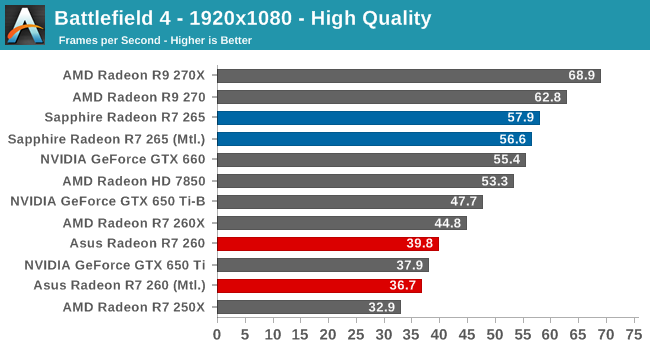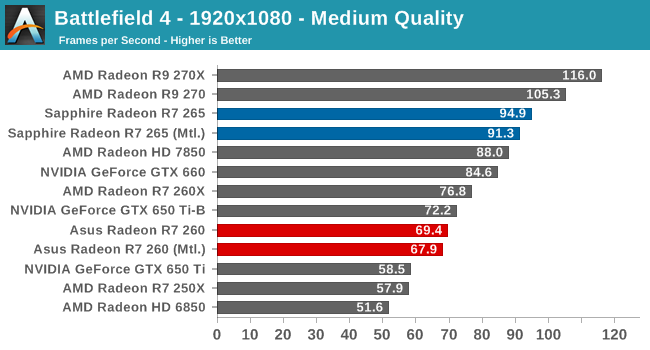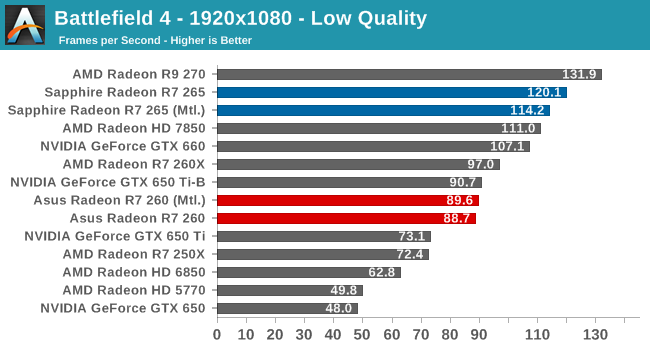The AMD Radeon R7 265 & R7 260 Review: Feat Sapphire & Asus
by Ryan Smith on February 13, 2014 8:00 AM ESTBattlefield 4
Our latest addition to our benchmark suite and our current major multiplayer action game of our benchmark suite is Battlefield 4, DICE’s 2013 multiplayer military shooter. After a rocky start, Battlefield 4 has finally reached a point where it’s stable enough for benchmark use, giving us the ability to profile one of the most popular and strenuous shooters out there. As these benchmarks are from single player mode, based on our experiences our rule of thumb here is that multiplayer framerates will dip to half our single player framerates, which means a card needs to be able to average at least 60fps if it’s to be able to hold up in multiplayer.



Our first review with Battlefield 4 finds AMD firmly in the driver’s seat, easily surpassing NVIDIA’s closest competitors while often putting more expensive NVIDIA cards in a bind. To this end we see that both the R7 265 and R7 260 are best suited for 1080p at medium quality, as the R7 265’s additional performance comes up a bit short of making high quality playable.
Ultimately we have the R7 260 beating the GTX 650 Ti by 19% and the R7 265 even beating the GTX 660, in the latter case by 12%. Unfortunately for AMD, Mantle is a bust here. In this GPU bound test Mantle is just as likely to cause a minor performance regression as it is to cause a minor performance improvement. Mantle’s strength is in CPU bound scenarios so this isn’t a big surprise, but it does reiterate the fact that Direct3D isn’t dead on AMD cards when you have the CPU power to keep it happy.










52 Comments
View All Comments
edzieba - Thursday, February 13, 2014 - link
It's not just a tool for flagging up multi-screen/multi-GPU stutter issues. By showing the distribution of frame times, you can tell the difference between two cards that both average 50fps, but where one delivers every frame in 20 +/- 1 ms, and the other at +/- 5. The latter will deliver a much smoother output, which is not apparent from a single-number metric.Anandtech readers are a pretty smart bunch. We'd much prefer Graph Overload to too little information, particularly when other sites provide the additional information as standard.
Death666Angel - Thursday, February 13, 2014 - link
Sounds like the first (+/- 1 ms) would deliver the smoother experience than the latter (+/- 5 ms). :)edzieba - Monday, February 17, 2014 - link
Urp, that's what I /meant/ to write...Cellar Door - Thursday, February 13, 2014 - link
This rebadge game is terrible. Both parties are guilty here but the fact that these products get reviewed on regular basis just makes no sense.Here is a proper review of the of the 265 and 260: Lets confuse everyone with new nomenclature and what basically is a 7850 from close to 2 years ago. These cards are nothing but cash cows for the mainstream.
This card is being launched to draw attention to AMD just before the GTX 750 Ti comes to the market, its nothing but emptying the stocks of poor quality chips.
MrSpadge - Thursday, February 13, 2014 - link
Guess what: they wouldn't build GPUs if they wouldn't expect them to be cash cows!EnzoFX - Thursday, February 13, 2014 - link
THis has always been the case in the not-high-tier cards. Where have you been? I love these cards. What's wrong with an "update" to tried and true cards. I love these single-pcie-power cards. Besides, most games will prob still be targeting this level of power considering it's comparable to the new consoles.Death666Angel - Thursday, February 13, 2014 - link
First time I can remember there being rebadging was with the 8xxx / 9xxx series from nVidia, before that I don't remember it happening.LordOfTheBoired - Friday, February 14, 2014 - link
GeForce4 MX was a modified GeForce2. While not a straight same-component relabel, it WAS intentionally-misleading branding meant to make people think it was an upgrade from the GeForce 3 rather than a downgrade, and was very much in the spirit of the modern rebadge.That's the earliest example that springs to mind here.
rallyhard - Friday, February 14, 2014 - link
I agree that your example, the GeForce4 MX is one of the earliest, and probably one of the most misleading rebrands ever.The first video card I ever purchased was a rebrand that occurred a year earlier, though: the lowly Radeon 7000. It was the exact same card as the previous RV100-based Radeon LE, but they gave it a flashy new name when they introduced the new Radeon 7500 with the RV200 chip.
silverblue - Friday, February 14, 2014 - link
The GeForce 4 MX was probably a worse release than the 2 MX in that the latter was indeed based on the GeForce 2, but lacked the hardware transform and lighting capabilities of the GeForce 2 GTS and the earlier GeForce 256. The GeForce 2 MX 400 was the only model that had a chance of beating the 256 DDR.The Radeon 9000 was a hacked down 8500 LE, but I suppose considering the low number in the 9xxx series, there had to be a low-end part. Besides which, it did still have T&L.
I can't think of any straight rebrands from back then apart from the 7000.